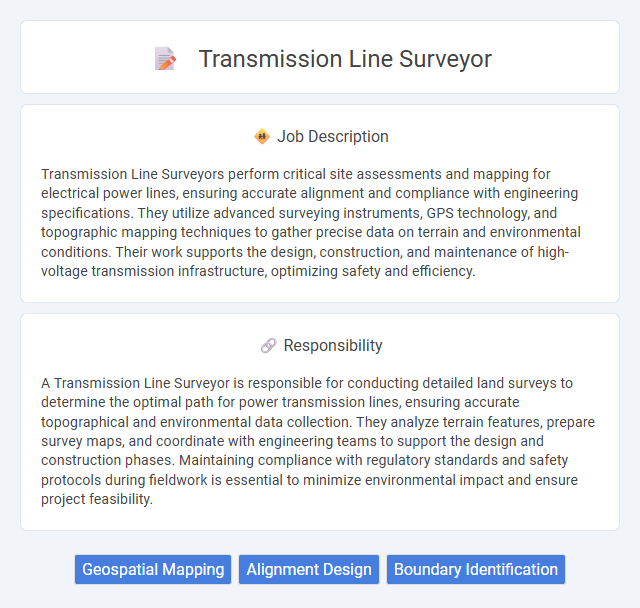
Transmission Line Surveyors perform critical site assessments and mapping for electrical power lines, ensuring accurate alignment and compliance with engineering specifications. They utilize advanced surveying instruments, GPS technology, and topographic mapping techniques to gather precise data on terrain and environmental conditions. Their work supports the design, construction, and maintenance of high-voltage transmission infrastructure, optimizing safety and efficiency.
Individuals with strong physical fitness and resilience are likely suitable for a Transmission Line Surveyor role, as the job often requires fieldwork in remote or rugged terrain under varying weather conditions. Those comfortable with outdoor environments and possessing good problem-solving skills may adapt well to the unpredictable nature of line surveying tasks. However, candidates with limitations in mobility or aversion to extended periods outdoors might find this position challenging.
Qualification
A Transmission Line Surveyor requires a strong background in civil engineering or surveying, often holding a diploma or degree in these fields. Proficiency in using GPS, GIS, and AutoCAD software is essential for accurately mapping and analyzing terrain for transmission line routes. Practical experience combined with knowledge of safety regulations and environmental guidelines ensures precise and compliant project execution.
Responsibility
A Transmission Line Surveyor is responsible for conducting detailed land surveys to determine the optimal path for power transmission lines, ensuring accurate topographical and environmental data collection. They analyze terrain features, prepare survey maps, and coordinate with engineering teams to support the design and construction phases. Maintaining compliance with regulatory standards and safety protocols during fieldwork is essential to minimize environmental impact and ensure project feasibility.
Benefit
A Transmission Line Surveyor is likely to benefit from competitive salaries and opportunities for career advancement within the energy sector. They may enjoy hands-on experience in diverse environments, enhancing technical skills and professional growth. Job stability is probable due to ongoing infrastructure development and maintenance demands.
Challenge
Transmission Line Surveyor roles likely involve the challenge of navigating difficult terrains and remote locations to accurately map power line routes. The necessity to interpret complex topographical data under variable weather conditions may increase the difficulty of fieldwork. Surveyors probably face tight project deadlines while ensuring compliance with safety and environmental regulations.
Career Advancement
A Transmission Line Surveyor plays a critical role in the planning and execution of electrical power transmission projects, gathering precise geographical and topographical data to ensure accurate line routing. Career advancement opportunities often lead to senior surveyor roles, project management positions, or specialized technical consultancy in energy infrastructure development. Gaining certifications in Geographic Information Systems (GIS) and advanced surveying technologies enhances prospects for leadership roles and higher salary brackets in the renewable energy sector.
Key Terms
Geospatial Mapping
Transmission Line Surveyors specialize in geospatial mapping to accurately chart electrical transmission corridors, utilizing advanced tools such as GPS, GIS, and drones. Their expertise enables precise topographical data collection critical for designing and maintaining power line infrastructure while ensuring compliance with environmental and regulatory standards. Skilled in spatial analysis, these surveyors contribute to the optimization of route planning and risk assessment in power transmission projects.
Alignment Design
Transmission Line Surveyors specializing in alignment design conduct precise topographical and environmental surveys to determine the optimal path for power lines. They utilize GPS technology, GIS mapping, and terrain analysis to create accurate alignment plans that minimize environmental impact and ensure structural stability. Their expertise directly influences the efficiency, safety, and cost-effectiveness of electrical transmission infrastructure development.
Boundary Identification
Transmission line surveyors specialize in boundary identification to ensure accurate placement and legal compliance of power line routes. They utilize advanced GPS technology, geographic information systems (GIS), and land records to delineate property lines and easements precisely. Their work minimizes disputes and facilitates smooth acquisition of right-of-way permits essential for transmission infrastructure development.
 kuljobs.com
kuljobs.com